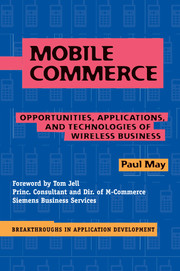Foreword
Published online by Cambridge University Press: 04 August 2010
Summary
At the dawn of the new millennium, some 5 billion people inhabited the earth. In the year 2002, the estimated number of cell phones in use around the world will be 500 million. That is to say, roughly one-tenth of the total world population will soon be using cell phones. Of these devices, perhaps 20 percent (rapidly increasing) are fully equipped for all facets of mobile commerce, including purchase, sale, and trading actions. This gives mobile commerce a significant market.
Once a useful gadget for notorious chatterboxes, the cell phone has significantly reshaped some basic activities of our daily lives. Thanks to an increasingly “always-on” lifestyle, shopping, banking, and making reservations are now commonplace transactions “in your pocket.” Expert observers take it as gospel truth that the majority of working adults will use a mobile device for their major commerce activities by the middle of the decade. For the business world the mobile commerce area beckons with a variety of opportunities to rejoin customers and partners in a decentralized, service-rich environment.
Hardware and software manufacturers are jumping on the bandwagon and heavily investing in the mobile commerce area. New technologies are designed to improve the bandwidth, speed, and performance of mobile devices, establishing them as serious competitors to fixed-line services once the desktop market is saturated.
- Type
- Chapter
- Information
- Mobile CommerceOpportunities, Applications, and Technologies of Wireless Business, pp. xi - xiiPublisher: Cambridge University PressPrint publication year: 2001



